Evaluation of the Impact of Rainfall Inputs on Urban Rainfall Models: A Systematic Review
Abstract
1. Introduction
2. Materials and Methods
2.1. Study Search and Selection
2.2. Model Performance Indicator Selection
2.2.1. Nash–Sutcliffe Efficiency
2.2.2. Root of the Mean Square Error
2.2.3. The Coefficient of Determination
2.2.4. Relative Error
2.3. Data Analysis
3. Results and Discussion
3.1. Overview of Urban Rain Flood Model Research Trends
3.2. Influence of Rainfall Calibration and Verification Times on Model Accuracy
3.3. Influence of Rain Measurement Method on Model Accuracy
3.4. Application of Web Crawling Rainfall Data in Model Input
4. Conclusions
Author Contributions
Funding
Acknowledgments
Conflicts of Interest
References
- Su, B.; Huang, H.; Zhu, W. An urban pluvial flood simulation model based on diffusive wave approximation of shallow water equations. Hydrol. Res. 2019, 50, 138–154. [Google Scholar] [CrossRef]
- Thrysoe, C.; Arnbjerg-Nielsen, K.; Borup, M. Identifying fit-for-purpose lumped surrogate models for large urban drainage systems using GLUE. J. Hydrol. 2019, 568, 517–533. [Google Scholar] [CrossRef]
- Roodsari, B.K.; Chandler, D.G.; Kelleher, C.; Kroll, C.N. A comparison of SAC-SMA and Adaptive Neuro-fuzzy Inference System for real-time flood forecasting in small urban catchments. J. Flood Risk Manag. 2019, 12, e12492. [Google Scholar] [CrossRef]
- Nkwunonwo, U.C.; Whitworth, M.; Bally, B. Urban flood modelling combining cellular automata framework with semi-implicit finite difference numerical formulation. J. Afr. Earth Sci. 2019, 150, 272–281. [Google Scholar] [CrossRef]
- Song, X.; Zhang, J.; Wang, G.; He, R.; Wang, X. Development and challenges of urban hydrology in a changing environment: Ⅱ: Urban stormwater modeling and management. Adv. Water Sci. 2014, 25, 752–764. [Google Scholar]
- Wang, S.; Wang, H. Extending the Rational Method for assessing and developing sustainable urban drainage systems. Water Res. 2018, 144, 112–125. [Google Scholar] [CrossRef]
- Gironas, J.; Roesner, L.A.; Rossman, L.A.; Davis, J. A new applications manual for the Storm Water Management Model (SWMM). Environ. Model. Softw. 2010, 25, 813–814. [Google Scholar] [CrossRef]
- Bach, P.M.; Rauch, W.; Mikkelsen, P.S.; McCarthy, D.T.; Deletic, A. A critical review of integrated urban water modelling Urban drainage and beyond. Environ. Model. Softw. 2014, 54, 88–107. [Google Scholar] [CrossRef]
- Zhao, G.; Pang, B.; Xu, Z.; Peng, D.; Xu, L. Assessment of urban flood susceptibility using semi-supervised machine learning model. Sci. Total Environ. 2019, 659, 940–949. [Google Scholar] [CrossRef]
- Verworn, H.R. Advances in urban-drainage management and flood protection. Philos. Trans. R. Soc. Lond. Ser. A Math. Phys. Eng. Sci. 2002, 360, 1451–1460. [Google Scholar] [CrossRef]
- Boughton, W. Catchment water balance modelling in Australia 1960–2004. Agric. Water Manag. 2005, 71, 91–116. [Google Scholar] [CrossRef]
- Winz, I.; Brierley, G.; Trowsdale, S. The Use of System Dynamics Simulation in Water Resources Management. Water Resour. Manag. 2009, 23, 1301–1323. [Google Scholar] [CrossRef]
- Xia, J.; Zhang, Y.; Liang, C.; Liu, J. Review on urban storm water models. Eng. J. Wuhan Univ. 2018, 51, 95–105. [Google Scholar]
- Yang, X.; Wang, Y. Cognition in the uncertainty and equifinality of hydrological model: A systematic review. J. Hydraul. Eng. 2018, 49, 136–143. [Google Scholar]
- Kitanidis, P.K.; Bras, R.L. Real-time forecasting with a conceptual hydrologic model. I. Analysis of uncertainty. Water Resour. Res. 1980, 16, 1025–1033. [Google Scholar] [CrossRef]
- Zhu, Z.; Chen, Z.; Chen, X.; Yu, G. An assessment of the hydrologic effectiveness of low impact development (LID) practices for managing runoff with different objectives. J. Environ. Manag. 2019, 231, 504–514. [Google Scholar] [CrossRef]
- Barszcz, M.P. Radar Data Analyses for a Single Rainfall Event and Their Application for Flow Simulation in an Urban Catchment Using the SWMM Model. Water 2018, 10, 1007. [Google Scholar] [CrossRef]
- Tian, X.; Veldhuis, M.C.T.; Schleiss, M.; Bouwens, C.; van de Giesen, N. Critical rainfall thresholds for urban pluvial flooding inferred from citizen observations. Sci. Total Environ. 2019, 689, 258–268. [Google Scholar] [CrossRef]
- Qi, L.; Tang, Q. The multi-case literature meta-analysis method and its research ideas. J. Beihang Univ. 2019, 32, 139–145. [Google Scholar]
- Sohn, W.; Kim, J.-H.; Li, M.-H.; Brown, R. The influence of climate on the effectiveness of low impact development: A systematic review. J. Environ. Manag. 2019, 236, 365–379. [Google Scholar] [CrossRef]
- Zhang, D.; Yan, D.; Wang, Y.; Lu, F.; Liu, S. Research Progress on Risk Assessment and Integrated Strategies for Urban Pluvial Flooding. J. Catastrophology 2014, 29, 144–149. [Google Scholar]
- El Fels, A.E.A.; Bachnou, A.; Alaa, N. Combination of GIS and mathematical modeling to predict floods in semiarid areas: Case of Rheraya watershed (Western High Atlas, Morocco). Arab. J. Geosci. 2017, 10, 554. [Google Scholar] [CrossRef]
- Peng, H.; Liu, Y.; Wang, H.; Gao, X.; Chen, Y.; Ma, L. Urban stormwater forecasting model and drainage optimization based on water environmental capacity. Environ. Earth Sci. 2016, 75, 1094. [Google Scholar] [CrossRef]
- Russo, B.; Sunyer, D.; Velasco, M.; Djordjevic, S. Analysis of extreme flooding events through a calibrated 1D/2D coupled model: The case of Barcelona (Spain). J. Hydroinform. 2015, 17, 473–491. [Google Scholar] [CrossRef]
- Liu, N.-N.; Rui, X.-F.; Feng, J. Jinan Urban Rainstorm Model Based on Lattice Boltzmann Method. Water Resour. Power 2016, 34, 48–52. [Google Scholar]
- Granata, F.; Gargano, R.; de Marinis, G. Support Vector Regression for Rainfall-Runoff Modeling in Urban Drainage: A Comparison with the EPA’s Storm Water Management Model. Water 2016, 8, 69. [Google Scholar] [CrossRef]
- Hu, C.; Wu, Q.; Li, H.; Jian, S.; Li, N.; Lou, Z. Deep Learning with a Long Short-Term Memory Networks Approach for Rainfall-Runoff Simulation. Water 2018, 10, 1543. [Google Scholar] [CrossRef]
- Chen, H.; Hong, L.; Mei, C.; Lai, Y.; Zeng, Z. Distributed simulation of urban storm water based on D8 algorithm. Eng. J. Wuhan Univ. 2016, 49, 335–340. [Google Scholar]
- Zoppou, C. Review of urban storm water models. Environ. Model. Softw. 2001, 16, 195–231. [Google Scholar] [CrossRef]
- Terstriep, M.L.; Stall, J.B. ILLUDAS—The Illinois Urban Drainage Area Simulator. In Proceedings of the National Symposium on Urban Rainfall and Runoff and Sediment Control, Lexington, KY, USA, 29–31 July 1974; Illinois State Water Survey: Champaign, IL, USA, 1974; pp. 73–83. [Google Scholar]
- Cantone, J.; Schmidt, A. Improved understanding and prediction of the hydrologic response of highly urbanized catchments through development of the Illinois Urban Hydrologic Model. Water Resour. Res. 2011, 47. [Google Scholar] [CrossRef]
- Koudelak, P.; West, S. Sewerage network modelling in Latvia, use of InfoWorks CS and Storm Water Management Model 5 in Liepaja city. Water Environ. J. 2008, 22, 81–87. [Google Scholar] [CrossRef]
- Chen, W.; Huang, G.; Zhang, H.; Wang, W. Urban inundation response to rainstorm patterns with a coupled hydrodynamic model: A case study in Haidian Island, China. J. Hydrol. 2018, 564, 1022–1035. [Google Scholar] [CrossRef]
- Ochoa-Rodriguez, S.; Wang, L.-P.; Gires, A.; Pina, R.D.; Reinoso-Rondinel, R.; Bruni, G.; Ichiba, A.; Gaitan, S.; Cristiano, E.; van Assel, J.; et al. Impact of spatial and temporal resolution of rainfall inputs on urban hydrodynamic modelling outputs: A multi-catchment investigation. J. Hydrol. 2015, 531, 389–407. [Google Scholar] [CrossRef]
- Huang, M.; Jin, S. A methodology for simple 2-D inundation analysis in urban area using SWMM and GIS. Nat. Hazards 2019, 97, 15–43. [Google Scholar] [CrossRef]
- Yang, G.; Xu, Z.; Zhao, G.; Chang, X.; Du, L. Simulating urban rainfall-runoff and assessing LID facilities by SWMM model in Dahongmen catchment. J. Beijing Norm. Univ. 2018, 54, 628–634. [Google Scholar]
- Szymczak, T.; Krezalek, K. Prognostic model of total runoff and its components from a partially urbanized small lowland catchment. Acta Sci. Pol. Form. Circumiectus 2018, 17, 185–203. [Google Scholar] [CrossRef]
- Babaei, S.; Ghazavi, R.; Erfanian, M. Urban flood simulation and prioritization of critical urban sub-catchments using SWMM model and PROMETHEE II approach. Phys. Chem. Earth 2018, 105, 3–11. [Google Scholar] [CrossRef]
- Chen, W.; Huang, G.; Zhang, H. Urban stormwater inundation simulation based on SWMM and diffusive overland-flow model. Water Sci. Technol. 2017, 76, 3392–3403. [Google Scholar] [CrossRef]
- Zhang, J.; Song, X.; Wang, G.; He, R.; Wang, X. Development and challenges of urban hydrology in a changing environment: I: Hydrological response to urbanization. Adv. Water Sci. 2014, 25, 594–605. [Google Scholar]
- Rai, P.K.; Chahar, B.R.; Dhanya, C.T. GIS-based SWMM model for simulating the catchment response to flood events. Hydrol. Res. 2017, 48, 384–394. [Google Scholar] [CrossRef]
- Shon, T.S.; Kim, S.D.; Cho, E.Y.; Im, J.Y.; Min, K.S.; Shin, H.S. Estimation of NPS pollutant properties based on SWMM modeling according to land use change in urban area. Desalin. Water Treat. 2012, 38, 333–341. [Google Scholar] [CrossRef]
- Rujner, H.; Leonhardt, G.; Marsalek, J.; Viklander, M. High-resolution modelling of the grass swale response to runoff inflows with Mike SHE. J. Hydrol. 2018, 562, 411–422. [Google Scholar] [CrossRef]
- Rangari, V.A.; Gopi, K.V.; Umamahesh, N.V.; Patel, A.K. Simulation of Urban Drainage System Using Disaggregated Rainfall Data. In Hydrologic Modeling; Singh, V.P., Yadav, S., Yadava, R.N., Eds.; Springer: Singapore, 2018; pp. 123–133. [Google Scholar]
- Her, Y.; Jeong, J. Swat plus versus swat2012: Comparison of sub-daily urban runoff simulations. Trans. Asabe 2018, 61, 1287–1295. [Google Scholar] [CrossRef]
- Zhu, Z.; Chen, X. Evaluating the Effects of Low Impact Development Practices on Urban Flooding under Different Rainfall Intensities. Water 2017, 9, 548. [Google Scholar] [CrossRef]
- Zhao, G.; Shi, R.; Pang, B.; Xu, Z.; Du, L.; Chang, X. Impact of rapid urbanization on rainfall-runoff processes in urban catchment: Case study for Liangshui River basin. J. Hydroelectr. Eng. 2016, 35, 55–64. [Google Scholar]
- Li, C.; Liu, M.; Hu, Y.; Gong, J.; Xu, Y. Modeling the Quality and Quantity of Runoff in a Highly Urbanized Catchment Using Storm Water Management Model. Pol. J. Environ. Stud. 2016, 25, 1573–1581. [Google Scholar] [CrossRef]
- Chang, X.; Xu, Z.; Zhao, G.; Du, L. Urban rainfall-runoff simulations and assessment of low impact development facilities using SWMM model-A case study of Qinghe catchment in Beijing. J. Hydroelectr. Eng. 2016, 35, 84–93. [Google Scholar]
- Akhter, M.S.; Hewa, G.A. The Use of PCSWMM for Assessing the Impacts of Land Use Changes on Hydrological Responses and Performance of WSUD in Managing the Impacts at Myponga Catchment, South Australia. Water 2016, 8, 511. [Google Scholar] [CrossRef]
- Guan, M.; Sillanpaa, N.; Koivusalo, H. Modelling and assessment of hydrological changes in a developing urban catchment. Hydrol. Process. 2015, 29, 2880–2894. [Google Scholar] [CrossRef]
- Baek, S.-S.; Choi, D.-H.; Jung, J.-W.; Yoon, K.-S.; Cho, K.-H. Evaluation of a hydrology and run-off BMP model in SUSTAIN on a commercial area and a public park in South Korea. Desalin. Water Treat. 2015, 55, 347–359. [Google Scholar] [CrossRef]
- Kim, H.I.; Keum, H.J.; Han, K.Y. Real-Time Urban Inundation Prediction Combining Hydraulic and Probabilistic Methods. Water 2019, 11, 293. [Google Scholar] [CrossRef]
- Akter, A.; Mohit, S.A.; Chowdhury, M.A.H. Predicting urban storm water-logging for Chittagong city in Bangladesh. Int. J. Sustain. Built Environ. 2017, 6, 238–249. [Google Scholar] [CrossRef]
- Liu, L.; Liu, Y.; Wang, X.; Yu, D.; Liu, K.; Huang, H.; Hu, G. Developing an effective 2-D urban flood inundation model for city emergency management based on cellular automata. Nat. Hazards Earth Syst. Sci. 2015, 15, 381–391. [Google Scholar] [CrossRef]
- Tanouchi, H.; Olsson, J.; Lindstrom, G.; Kawamura, A.; Amaguchi, H. Improving Urban Runoff in Multi-Basin Hydrological Simulation by the HYPE Model Using EEA Urban Atlas: A Case Study in the Sege River Basin, Sweden. Hydrology 2019, 6, 28. [Google Scholar] [CrossRef]
- Xu, Z.; Cheng, T. Basic theory for urban water management and sponge city-review on urban hydrology. J. Hydraul. Eng. 2019, 50, 53–61. [Google Scholar]
- Dong-Eon, K.; Gourbesville, P.; Shie-Yui, L. Overcoming data scarcity in flood hazard assessment using remote sensing and artificial neural network. Smart Water 2019, 4, 2. [Google Scholar]
- de Souza, B.A.; da Silva Rocha Paz, I.; Ichiba, A.; Willinger, B.; Gires, A.; Amorim, J.C.C.; de Miranda Reis, M.; Tisserand, B.; Tchiguirinskaia, I.; Schertzer, D. Multi-hydro hydrological modelling of a complex peri-urban catchment with storage basins comparing C-band and X-band radar rainfall data. Hydrol. Sci. J. 2018, 63, 1619–1635. [Google Scholar] [CrossRef]
- Yoon, S.-S.; Nakakita, E. Application of an X-Band Multiparameter Radar Network for Rain-Based Urban Flood Forecasting. J. Hydrol. Eng. 2017, 22, e5015005. [Google Scholar] [CrossRef]
- Borup, M.; Grum, M.; Linde, J.J.; Mikkelsen, P.S. Dynamic gauge adjustment of high-resolution X-band radar data for convective rain storms: Model-based evaluation against measured combined sewer overflow. J. Hydrol. 2016, 539, 687–699. [Google Scholar] [CrossRef]
- Woodson, D.; Adams, T.E., III; Dymond, R. Precipitation Estimation Methods in Continuous, Distributed Urban Hydrologic Modeling. Water 2019, 11, 1340. [Google Scholar] [CrossRef]
- Habibi, H.; Dasgupta, I.; Noh, S.; Kim, S.; Zink, M.; Seo, D.-J.; Matthew, B.; Branko, K. High-resolution hydrologic forecasting for very large urban areas. J. Hydroinform. 2019, 21, 441–454. [Google Scholar] [CrossRef]
- Barszcz, M.P. Quantitative rainfall analysis and flow simulation for an urban catchment using input from a weather radar. Geomat. Nat. Hazards Risk 2019, 10, 2129–2144. [Google Scholar] [CrossRef]
- Yonese, Y.; Kawamura, A.; Amaguchi, H. Storm Runoff Prediction Using Rainfall Radar Map Supported by Global Optimization Methodology. In Ibero-American Conference on Artificial Intelligence; Springer: Berlin/Heidelberg, Germany, 2018. [Google Scholar]
- Yoon, S.-S. Adaptive Blending Method of Radar-Based and Numerical Weather Prediction QPFs for Urban Flood Forecasting. Remote Sens. 2019, 11, 642. [Google Scholar] [CrossRef]
- Yoon, S.-S.; Lee, B. Effects of Using High-Density Rain Gauge Networks and Weather Radar Data on Urban Hydrological Analyses. Water 2017, 9, 931. [Google Scholar] [CrossRef]
- Hossain, I.; Esha, R.; Imteaz, M.A. An Attempt to Use Non-Linear Regression Modelling Technique in Long-Term Seasonal Rainfall Forecasting for Australian Capital Territory. Geosciences 2018, 8, 282. [Google Scholar] [CrossRef]
- Yilmaz, A.G.; Hossain, I.; Perera, B.J.C. Effect of climate change and variability on extreme rainfall intensity-frequency-duration relationships: A case study of Melbourne. Hydrol. Earth Syst. Sci. 2014, 18, 4065–4076. [Google Scholar] [CrossRef]
- Yu, D.; Yin, J.; Liu, M. Validating city-scale surface water flood modelling using crowd-sourced data. Environ. Res. Lett. 2016, 11, 124011. [Google Scholar] [CrossRef]
- Wu, Z.; Shen, Y.; Wang, H. Research progress on data fusion of multi-source urban rainstorm forecast. Water Resour. Hydropower Eng. 2018, 49, 15–21. [Google Scholar]
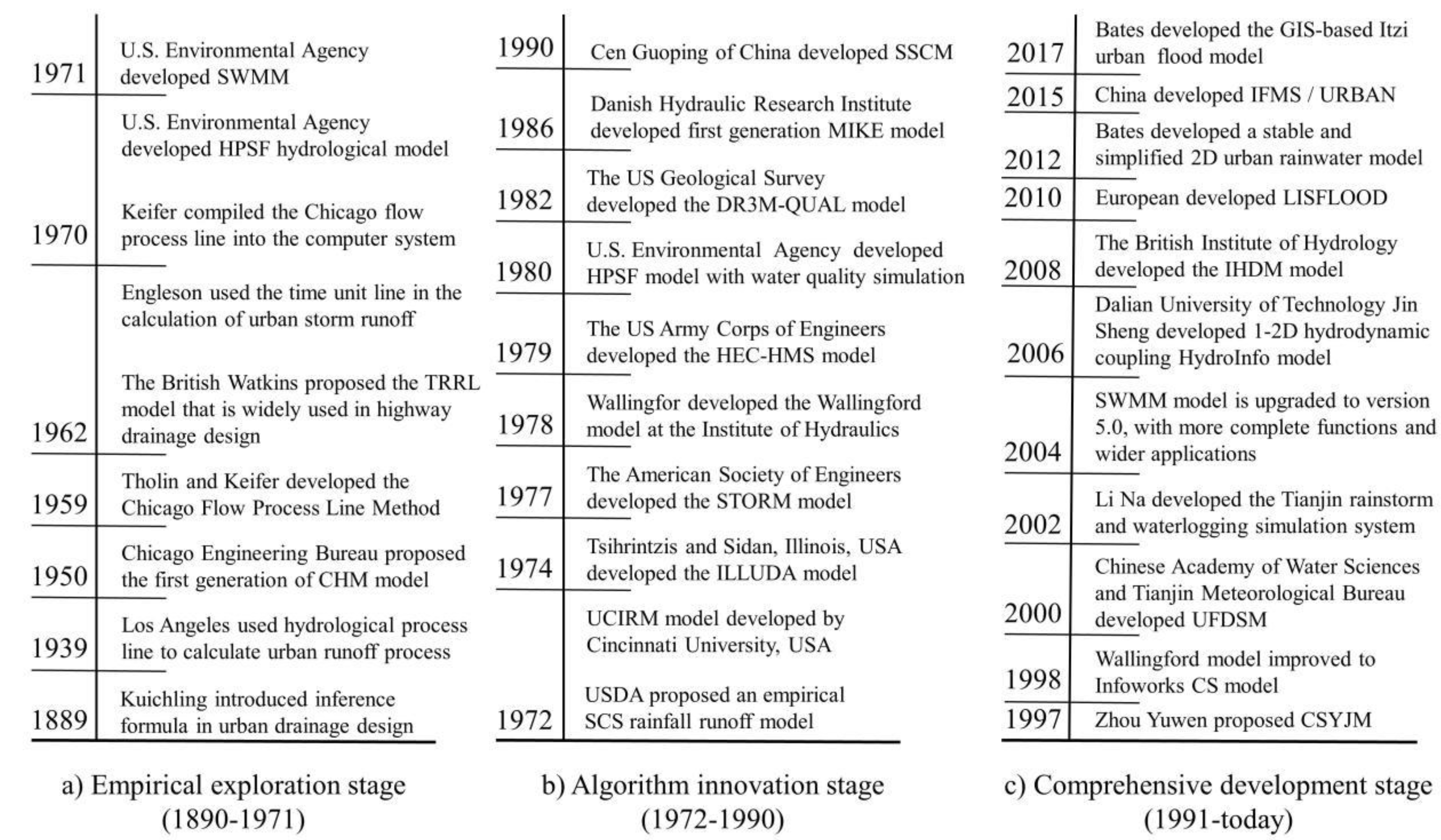
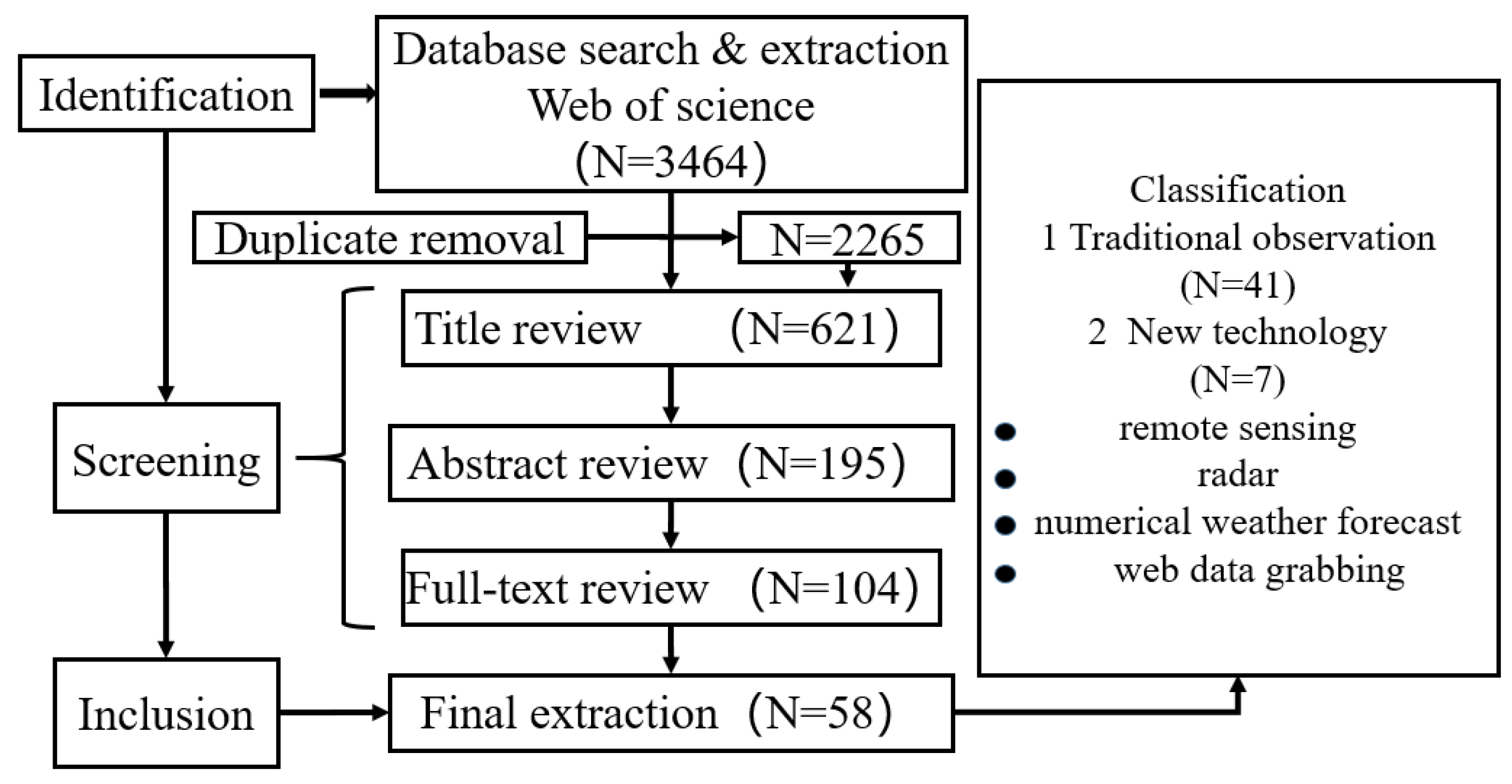
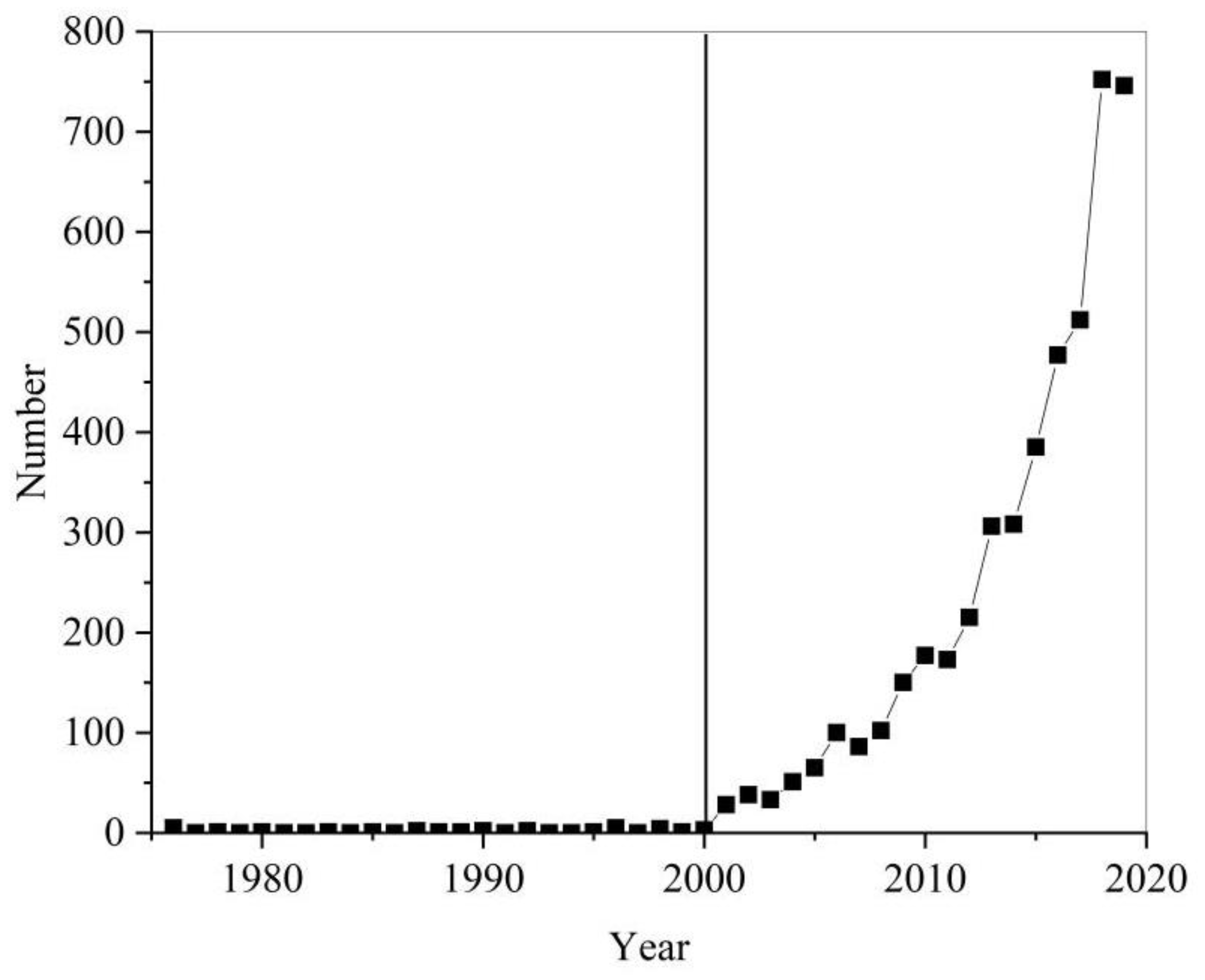
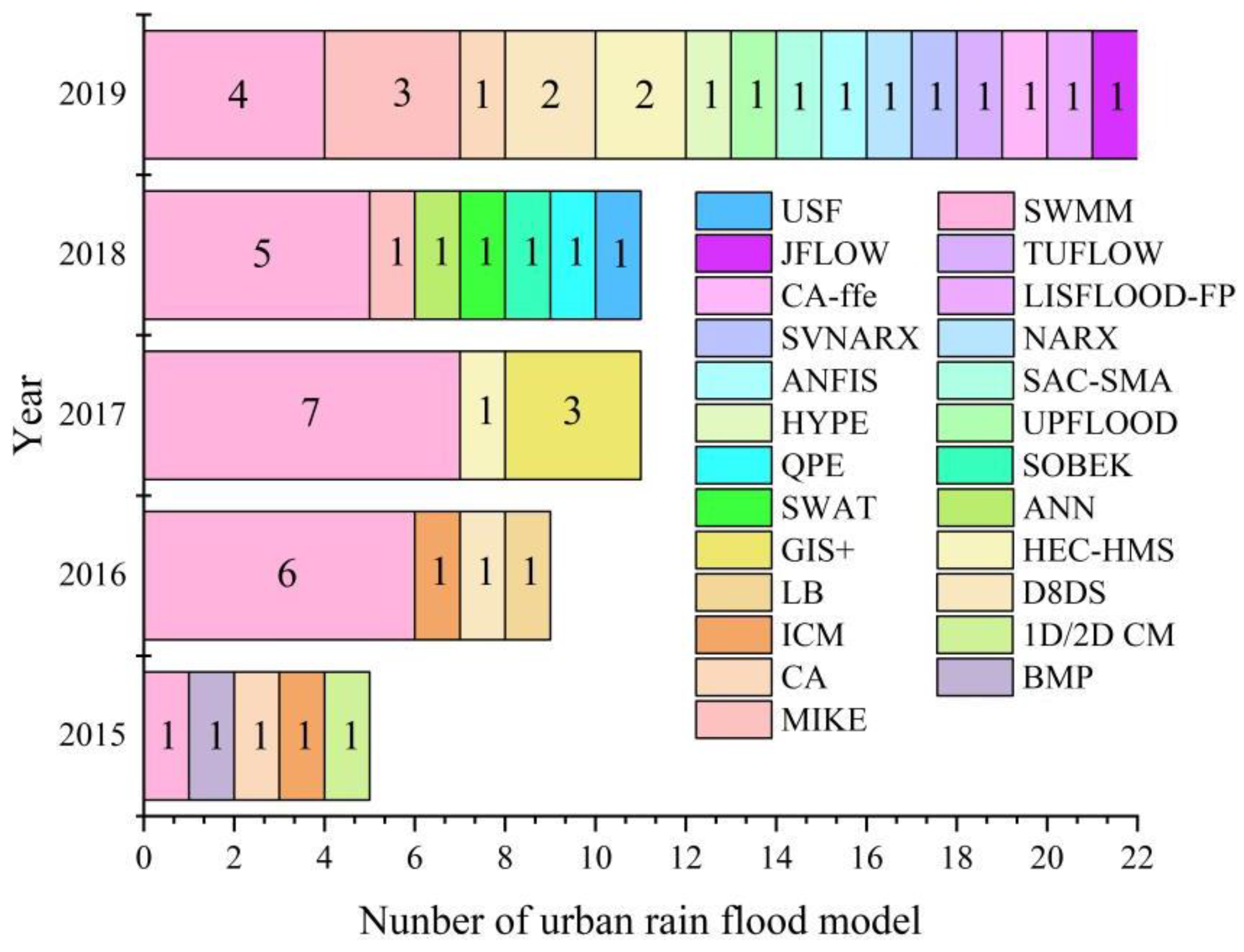
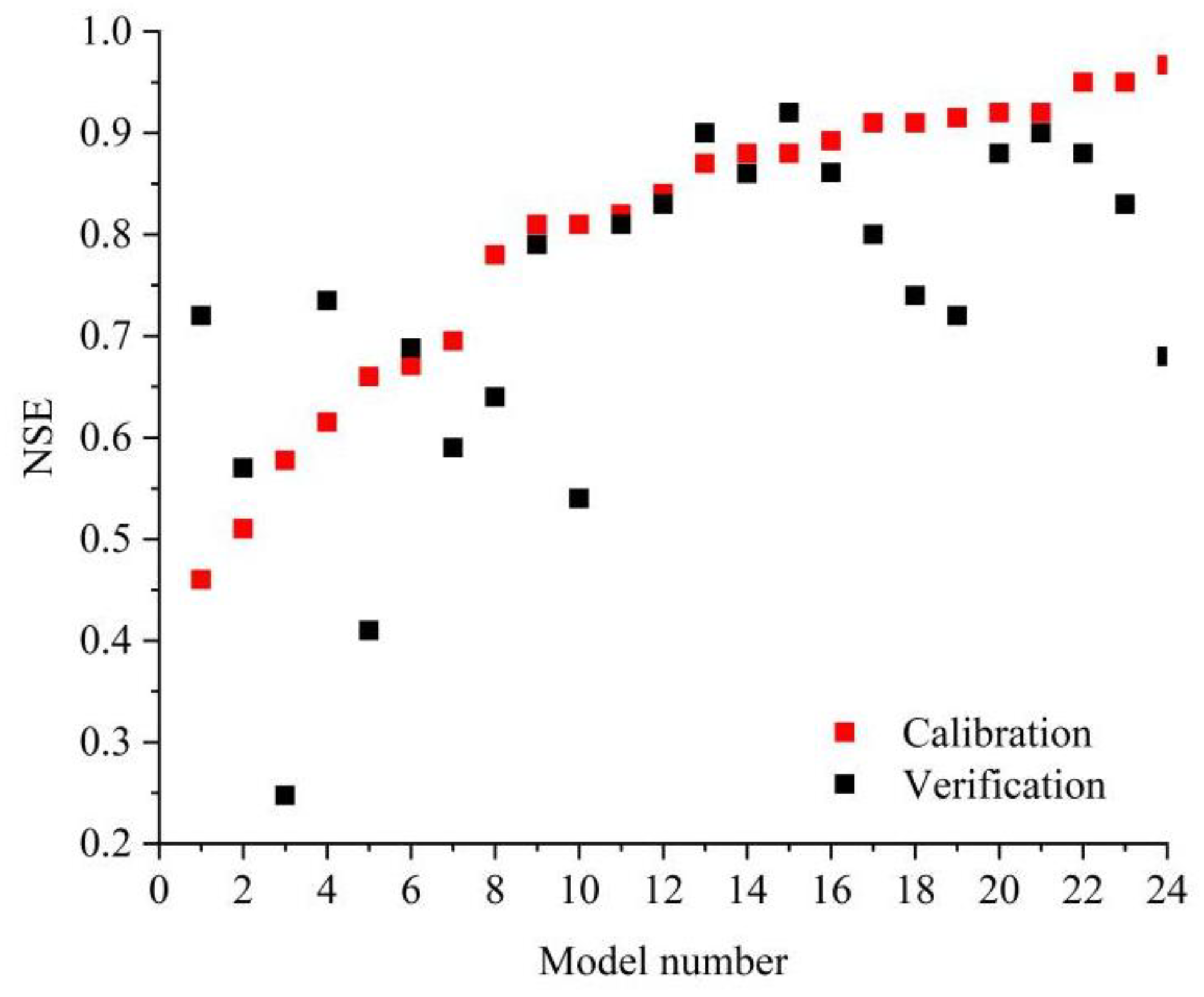
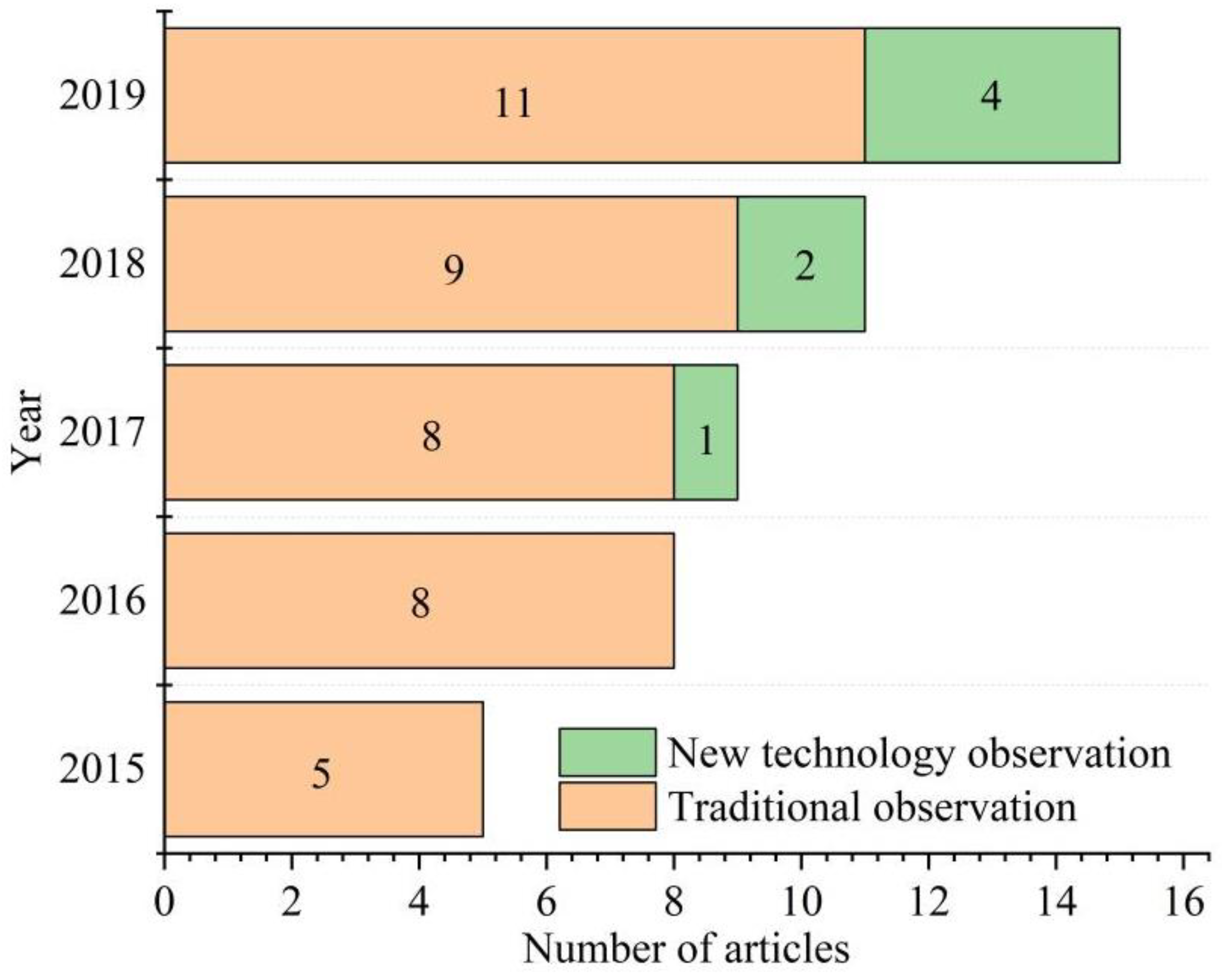
| Number | Author | Journal | Year | Location | Model | Rainfall Input |
|---|---|---|---|---|---|---|
| 1 | Zhu, Zhihua | Journal of Environmental Management | 2019 | Guangzhou, China | EPA SWMM | Rainfall station |
| 2 | Thrysoe, Cecilie | Journal of Hydrology | 2019 | Melbourne, Australia | MIKE urban | Rainfall station |
| 3 | Tanouchi, Hiroto | Hydrology | 2019 | Malmo, Sweden | HYPEcor and HYPEua | Rainfall station |
| 4 | Su, Boni | Hydrology Research | 2019 | Beijing, China | UPFLOODand LISFLOOD-FP and JFLOW | Rainfall station |
| 5 | Roodsari, Babak K. | Journal of Flood Risk Management | 2019 | New Jersey, US | SAC-SMA and ANFIS | Rainfall station |
| 6 | Nkwunonwo, U. C. | Journal of African Earth Sciences | 2019 | Lagos, Nigeria | CA | Rainfall station |
| 7 | Mengjing, guo | IOP Conference Series: Earth and Environmental Science | 2019 | Xiaoyi, China | MIKE 21 and MIKE URBAN | Rainfall station |
| 8 | Kolerski, Tomasz | Acta Scientiarum Polonorum-Formatio Circumiectus | 2019 | Gdańska, Poland | HEC-HMS | Rainfall station |
| 9 | Kim, Hyun Il | Water | 2019 | Seoul, Korea | NARX and SVNARX | Rainfall station |
| 10 | Jamali, Behzad | Water Resources Research | 2019 | Melbourne, Australia | CA-ffe and HEC-RAS and TUFLOW | Rainfall station |
| 11 | Huang, Minmin | Natural Hazards | 2019 | Zhangzhou, China | SWMM | Rainfall station |
| 12 | Yang, Gang | Journal of Beijing Normal University (Natural Science) | 2018 | Beijing, China | SWMM | Rainfall station |
| 13 | Szymczak, Tomasz | Acta Scientiarum Polonorum-Formatio Circumiectus | 2018 | Poland | SWMM | Rainfall station |
| 14 | Rujner, Hendrik | Journal of Hydrology | 2018 | Lulea, Sweden | Mike SHE | Rainfall station |
| 15 | Rangari, Vinay Ashok | Hydrologic Modeling | 2018 | Hyderabad Metropolitan, India | ANN and SWMM | Rainfall station |
| 16 | Luo, Pingping | Scientific Reports | 2018 | Hanoi, Vietnam | Calibrated flood inundation model | Rainfall station |
| 17 | Her, Y. | Transactions of the Asabe | 2018 | Texas, US | SWAT+ and AWAT2012 | Rainfall station |
| 18 | Chang, Che-Hao | Water | 2018 | Taiwan, China | SOBEK | Rainfall station |
| 19 | Babaei, Sahar | Physics and Chemistry of the Earth | 2018 | Urmia, Iran | SWMM | Rainfall station |
| 20 | Yoon, Seong-Sim | Water | 2017 | Gangnam, Korea | QPE | Rainfall station |
| 21 | Rai, Pawan Kumar | Hydrology Research | 2017 | Orissa, India | GIS+SWMM | Rainfall station |
| 22 | El Alaoui El Fels | Arabian Journal of Geosciences | 2017 | Tahanaout, Morocco | GIS+(Horton/SIG) | Rainfall station |
| 23 | Chen, Wenjie | Water Science and Technology | 2017 | Haikou, China | SWMM+GIS | Rainfall station |
| 24 | Carson, Tyler | Urban Water Journal | 2017 | New York, US | CN and CRE and SWMM and HELP | Rainfall station |
| 25 | Cai, Qingni | Water Resources Protection | 2017 | Guangzhou, China | SWMM | Rainfall station |
| 26 | Alamdari, Nasrin | Water | 2017 | Fairfax, US | SWMM | Rainfall station |
| 27 | Zhu, Zhihua | Water | 2017 | Guangzhou, China | SWMM | Rainfall station |
| 28 | Akter, A. | International Journal of Sustainable Built Environment | 2017 | Chittagong, Bangladesh | HEC-HMS | Rainfall station |
| 29 | Zhao, Gang | Journal of Hydroelectric Engineering | 2016 | Beijing, China | SWMM | Rainfall station |
| 30 | Peng, Haiqin | Environmental Earth Sciences | 2016 | Fuzhou, China | Infoworks | Rainfall station |
| 31 | Liu, Ning-ning | Water Resources and Power | 2016 | Jinan, China | Lattice Boltzmann | Rainfall station |
| 32 | Li, Chunlin | Polish Journal of Environmental Studies | 2016 | Shenyang, China | SWMM | Rainfall station |
| 33 | Granata, Francesco | Water | 2016 | Merate, Italy | SWMM | Rainfall station |
| 34 | Chen, Hao | Engineering Journal of Wuhan University | 2016 | Wuhan, China | D8 algorithm | Rainfall station |
| 35 | Chang, Xiaodong | Journal of Hydroelectric Engineering | 2016 | Beijing, China | SWMM | Rainfall station |
| 36 | Akhter, Muhammad Saleem | Water | 2016 | Adelaide, Australia | PCSWMM | Rainfall station |
| 37 | Russo, Beniamino | Journal of Hydroinformatics | 2015 | Barcelona, Spain | 1D/2D coupled model | Rainfall station |
| 38 | Peng, Hai-Qin | Environmental Science and Pollution Research | 2015 | Shanghai, China | InfoWorks | Rainfall station |
| 39 | Liu, L. | Natural Hazards and Earth System Sciences | 2015 | Guangzhou, China | CA | Rainfall station |
| 40 | Guan, Mingfu | Hydrological Processes | 2015 | Espoo, Finland | SWMM | Rainfall station |
| 41 | Baek, Sang-Soo | Desalination and Water Treatment | 2015 | Gwangju, South Korea | BMP | Rainfall station |
| 42 | Woodson, David | Water | 2019 | Virginia, US | RDHM | Radar observation |
| 43 | Habibi, Hamideh | Journal of Hydroinformatics | 2019 | Fort Worth et al., US | NWS | Radar observation |
| 44 | Barszcz, Mariusz Pawel | Geomatics Natural Hazards and Risk | 2019 | Warsaw, Poland | SWMM | Radar observation |
| 45 | Simari, G. R. | Advances in Artificial Intelligence | 2018 | Tokyo, Japan | USF | Radar observation |
| 46 | Barszcz, Mariusz Pawel | Water | 2018 | Warsaw, Poland | SWMM | Radar observation |
| 47 | Yoon, Seong-Sim | Water | 2017 | Seoul, Korea | SWMM | Numerical weather forecast |
| 48 | Yoon, Seong-Sim | Remote Sensing | 2019 | Seoul, Korea | SWMM and GIAM | Remote sensing |
| Number | Title | |||||
| 1 | An assessment of the hydrologic effectiveness of low impact development (LID) practices for managing runoff with different objectives | |||||
| 2 | Identifying fit-for-purpose lumped surrogate models for large urban drainage systems using GLUE | |||||
| 3 | Improving urban runoff in multi-basin hydrological simulation by the HYPE model using EEA urban atlas: a case study in the Sege river basin, Sweden | |||||
| 4 | An urban pluvial flood simulation model based on diffusive wave approximation of shallow water equations | |||||
| 5 | A comparison of SAC-SMA and Adaptive Neuro-fuzzy Inference System for real-time flood forecasting in small urban catchments | |||||
| 6 | Urban flood modelling combining cellular automata framework with semi-implicit finite difference numerical formulation | |||||
| 7 | Stormwater simulation based on the concept of sustainable development of sponge city construction | |||||
| 8 | Mathematical modeling of flood management system in the city of Gdansk, Orunski stream case study | |||||
| 9 | Real-time urban inundation prediction combining hydraulic and probabilistic methods | |||||
| 10 | A cellular automata fast flood evaluation (CA-ffe) model | |||||
| 11 | A methodology for simple 2-D inundation analysis in urban area using SWMM and GIS | |||||
| 12 | Simulating urban rainfall-runoff and assessing LID facilities by SWMM model in Dahongmen catchment | |||||
| 13 | Prognostic model of total runoff and its components from a partially urbanized small lowland catchment | |||||
| 14 | High-resolution modelling of the grass swale response to runoff inflows with Mike SHE | |||||
| 15 | Simulation of urban drainage system using disaggregated rainfall data | |||||
| 16 | Flood inundation assessment for the Hanoi Central Area, Vietnam under historical and extreme rainfall conditions | |||||
| 17 | SWAT plus versus SWAT 2012: comparison of sub-daily urban runoff simulations | |||||
| 18 | A case study for the application of an operational two-dimensional real-time flooding forecasting system and smart water level gauges on Roadsin Tainan city, Taiwan | |||||
| 19 | Urban flood simulation and prioritization of critical urban sub-catchments using SWMM model and PROMETHEE II approach | |||||
| 20 | Effects of using high-density rain gauge networks and weather radar data on urban hydrological analyses | |||||
| 21 | GIS-based SWMM model for simulating the catchment response to flood events | |||||
| 22 | Combination of GIS and mathematical modeling to predict floods in semiarid areas: case of Rheraya watershed (Western High Atlas, Morocco) | |||||
| 23 | Urban stormwater inundation simulation based on SWMM and diffusive overland-flow model | |||||
| 24 | Assessing methods for predicting green roof rainfall capture: A comparison between full-scale observations and four hydrologic models | |||||
| 25 | Simulation of control efficiency of low impact development measures for urban stormwater | |||||
| 26 | Assessing the effects of climate change on water quantity and quality in an urban watershed using a calibrated stormwater model | |||||
| 27 | Evaluating the effects of low impact development practices on urban flooding under different rainfall intensities | |||||
| 28 | Predicting urban storm water-logging for Chittagong city in Bangladesh | |||||
| 29 | Impact of rapid urbanization on rainfall-runoff processes in urban catchment: Case study for Liangshui River basin | |||||
| 30 | Urban stormwater forecasting model and drainage optimization based on water environmental capacity | |||||
| 31 | Jinan urban rainstorm model based on lattice boltzmann method | |||||
| 32 | Modeling the quality and quantity of runoff in a highly urbanized catchment using storm water management model | |||||
| 33 | Support vector regression for rainfall-runoff modeling in urban drainage: A comparison with the EPA’s storm water management model | |||||
| 34 | Distributed simulation of urban storm water based on D8 algorithm | |||||
| 35 | Urban rainfall-runoff simulations and assessment of low impact development facilities using SWMM model-A case study of Qinghe catchment in Beijing | |||||
| 36 | The use of PCSWMM for assessing the impacts of land use changes on hydrological responses and performance of WSUD in managing the impacts at Myponga catchment, South Australia | |||||
| 37 | Analysis of extreme flooding events through a calibrated 1D/2D coupled model: the case of Barcelona (Spain) | |||||
| 38 | Assessment of the service performance of drainage system and transformation of pipeline network based on urban combined sewer system model | |||||
| 39 | Developing an effective 2-D urban flood inundation model for city emergency management based on cellular automata | |||||
| 40 | Modelling and assessment of hydrological changes in a developing urban catchment | |||||
| 41 | Evaluation of a hydrology and run-off BMP model in SUSTAIN on a commercial area and a public park in South Korea | |||||
| 42 | Precipitation estimation methods in continuous, distributed urban hydrologic modeling | |||||
| 43 | High-resolution hydrologic forecasting for very large urban areas | |||||
| 44 | Quantitative rainfall analysis and flow simulation for an urban catchment using input from a weather radar | |||||
| 45 | Storm runoff prediction using rainfall radar map supported by global optimization methodology | |||||
| 46 | Radar data analyses for a single rainfall event and their application for flow simulation in an urban catchment using the SWMM model | |||||
| 47 | Effects of using high-density rain gauge networks and weather radar data on urban hydrological analyses | |||||
| 48 | Adaptive blending method of radar-based and numerical weather prediction QPFs for urban flood forecasting | |||||
| Authors | Location | Model | Calibration Times | Study Area Scale (km2) | Evaluation Index | |||
|---|---|---|---|---|---|---|---|---|
| NSE | RMSE | R2 | RE | |||||
| Su, Bon (2019) | Beijing, China | UPFLOOD LISFLOOD-FPJFLOW | Single | 1.65 | - | 0.000026/0.0000285/ 0.0000292 m3/s (flow) | - | - |
| Kim, Hyun Il (2019) | Seoul, Korea | NARX SVNARX | Single | 7.4 | 0.61/0.81 (flow) | - | - | - |
| Chen, Wenjie (2017) | Haikou, China | SWMM+GIS | Single | 13.8 | - | - | - | 14.2% (depth) |
| Akter, A. (2017) | Chittagong, Bangladesh | HEC-HMS | Single | 157 | - | - | 0.77 | - |
| Chen, Hao (2016) | Wuhan, China | D8DS | Single | 479.71 | - | - | - | 14.50% (depth) |
| Liu, L. (2015) | Guangzhou, China | CA | Single | 0.2 | 0.85 (flow) | - | 0.965 | - |
| Authors | Location | Model | Calibration Times | Study Area Scale (km2) | Evaluation Index | |||
|---|---|---|---|---|---|---|---|---|
| NSE | RMSE | R2 | RE | |||||
| Zhu, Zhihua (2019) | Guangzhou, China | EPA SWMM | 12 | 0.155 | 0.64 (flow) | - | - | - |
| Tanouchi, Hiroto (2019) | Malmo, Sweden | HYPEcor | Three consecutive years | 52 | 0.66 (flow) | - | - | - |
| Rujner, Hendrik (2018) | Lulea, Sweden | Mike-SHE | 4 | 0.000015 | 0.68 (flow) | - | - | - |
| Rangari, Vinay Ashok (2018) | Hyderabad | ANN+SWMM | 4 | 21.92 | 0.25 (flow) | - | 0.6975 (flow) | - |
| Zhao, Gang (2016) | Beijing, China | SWMM | 2 | 131.48 | 0.735 (flow) | - | - | 10.5% (peak flow) |
| Chang, Xiaodong (2016) | Beijing, China | SWMM | 2 | 235.27 | 0.59 (flow) | - | - | 29.90% (peak flow) |
| Authors | Location | Model | Method | Study Area (km2) | Evaluation Index | |||
|---|---|---|---|---|---|---|---|---|
| NSE | RMSE | R2 | RE | |||||
| Woodson, David (2019) | Virginia, US | RDHM | Radar | 19.4 | - | 2.69 m3/s (flow) | - | 131% (peak flow) |
| Habibi, Hamideh (2019) | Fort Worth et al., US | The NWS Research Hydrologic Distributed Model | Radar | 7.7–54.3 | >0.6 (flow) | - | >0.8 (flow) | - |
| Barszcz, Mariusz Pawel (2019) | Warsaw, Poland | SWMM | Radar | 55.2 | - | - | - | 8.7% (peak flow) |
| Simari, G. R. (2018) | Tokyo, Japan | USF | Radar | 7.7 | - | 0.0102 m3/s (flow) | - | 12.25% (peak flow) |
| Barszcz, Mariusz Pawel (2018) | Warsaw, Poland | SWMM | Radar | 16.5, 43.0 | - | - | - | 9.12%, 24.76% (flow); 7.85%, 25.75% (Runoff) |
| Yoon, Seong-Sim (2019) | Seoul, Korea | SWMM&GIAM | Remote sensing | 7.4 | - | 0.22–1.02 m3/s (flow) | 0.01–0.95 | - |
| Yoon, Seong-Sim (2017) | Seoul, Korea | SWMM | Numerical weather forecast | 605 | - | 0.194 mm (depth) | - | 24.55% (depth) |
| Authors | Location | Model | Method | Study Area (km2) | Evaluation Index | |||
|---|---|---|---|---|---|---|---|---|
| NSE | RMSE | R2 | RE | |||||
| Huang, Minmin (2019) | Zhangzhou, China | SWMM | Rain station | 6 | - | - | - | 5.69% (peak flow) |
| Roodsari, Babak K. (2019) | New Jersey, US | SAC-SMA/ANFIS | Rain station | 17–150 | 0.79–0.83 (flow) | - | - | - |
| Thrysoe, Cecilie (2019) | Melbourne, Australia | MIKE urban | Rain station | 45 | 0.96 (flow) | - | - | - |
| Zhao, Gang (2016) | Beijing, China | SWMM | Rain station | 60 | - | - | - | 7.5% (peak flow) |
| Granata, Francesco (2016) | Merate, Italy | SWMM | Rain station | 11.35, 98.82 | - | - | - | 4.05–20.45% (Runoff) |
| Akter, A. (2017) | Chittagong, Bangladesh | HEC-HMS | Rain station | 7.4 | - | - | 0.77 | - |
© 2020 by the authors. Licensee MDPI, Basel, Switzerland. This article is an open access article distributed under the terms and conditions of the Creative Commons Attribution (CC BY) license (http://creativecommons.org/licenses/by/4.0/).
Share and Cite
Hu, C.; Liu, C.; Yao, Y.; Wu, Q.; Ma, B.; Jian, S. Evaluation of the Impact of Rainfall Inputs on Urban Rainfall Models: A Systematic Review. Water 2020, 12, 2484. https://doi.org/10.3390/w12092484
Hu C, Liu C, Yao Y, Wu Q, Ma B, Jian S. Evaluation of the Impact of Rainfall Inputs on Urban Rainfall Models: A Systematic Review. Water. 2020; 12(9):2484. https://doi.org/10.3390/w12092484
Chicago/Turabian StyleHu, Caihong, Chengshuai Liu, Yichen Yao, Qiang Wu, Bingyan Ma, and Shengqi Jian. 2020. "Evaluation of the Impact of Rainfall Inputs on Urban Rainfall Models: A Systematic Review" Water 12, no. 9: 2484. https://doi.org/10.3390/w12092484
APA StyleHu, C., Liu, C., Yao, Y., Wu, Q., Ma, B., & Jian, S. (2020). Evaluation of the Impact of Rainfall Inputs on Urban Rainfall Models: A Systematic Review. Water, 12(9), 2484. https://doi.org/10.3390/w12092484




